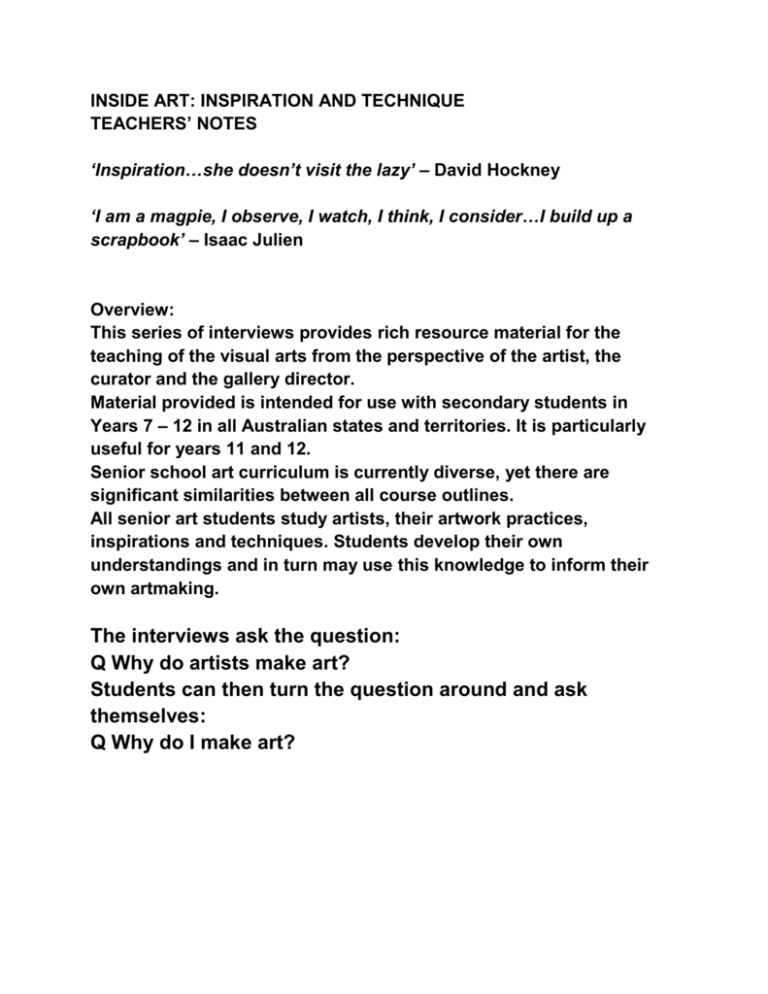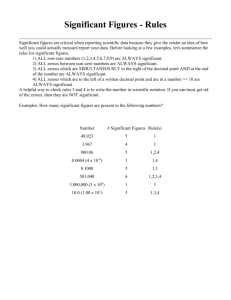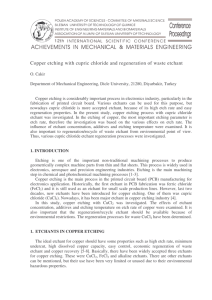INSIDE ART: INSPIRATION AND TECHNIQUE TEACHERS` NOTES
advertisement

INSIDE ART: INSPIRATION AND TECHNIQUE TEACHERS’ NOTES ‘Inspiration…she doesn’t visit the lazy’ – David Hockney ‘I am a magpie, I observe, I watch, I think, I consider…I build up a scrapbook’ – Isaac Julien Overview: This series of interviews provides rich resource material for the teaching of the visual arts from the perspective of the artist, the curator and the gallery director. Material provided is intended for use with secondary students in Years 7 – 12 in all Australian states and territories. It is particularly useful for years 11 and 12. Senior school art curriculum is currently diverse, yet there are significant similarities between all course outlines. All senior art students study artists, their artwork practices, inspirations and techniques. Students develop their own understandings and in turn may use this knowledge to inform their own artmaking. The interviews ask the question: Q Why do artists make art? Students can then turn the question around and ask themselves: Q Why do I make art? Artists featured on this video: 1. Rona Green - Painting ‘I amalgamate and collage my interests.’ 2. Marion Borgelt - Mixed-Media ‘My colour palette is off-key.’ 3. Geoffrey Ricardo - Sculpture and Etching ‘Copper is the starting point.’ 4. Sally Smart - Installation ‘I am interested in mapping space.’ 5. John Forrest - Oil Painting ‘I want to avoid a linear narrative in my work.’ When students are asked to analyse artworks, it is important that they LINK the following together: 1. The meanings and ideas behind the artwork 2. The materials and techniques used in the artwork 3. The Elements and Principles of Art seen in the artwork To look at meanings, materials or formal aspects in isolation does not give an in-depth understanding of the artistic process. The Inside Art series of interviews gives an insight into the artistic process. Students gain valuable insights into HOW and WHY artists work the way they do. These insights will also help with their own art practice, when they ask themselves how and why they work the way they do. Using the Inspiration and Techniques video, students can ask themselves: Why is copper sheet the preferred medium for Geoffrey Ricardo’s sculptural elephants and etchings? How does Rona Green combine tattooing, rabbits and her partner in her portraits? Why is Sally Smart driven to explore American Punk and postcolonial discourse in her art? How do Marion Borgelt’s use of Colour, Repetition and Contrast help to get her messages across? How does John Forrest create a sense of dysfunctional reality in his paintings? A useful template for students to use when viewing these interviews: Artist: MEANINGS IDEAS SUBJECT MATTER INFLUENCES MATERIALS AND TECHNIQUES ELEMENTS AND PRINCIPLES Students take brief notes while watching the videos, discuss their findings as a group, then do further research and write extended responses LINKING the three categories together and weaving in quotes taken from the videos. An Example of note-taking for Geoffrey Ricardo: MEANINGS IDEAS SUBJECT MATTER INFLUENCES The elephant Extinction People and animals Pinocchio Copper as the subject matter MATERIALS AND TECHNIQUES ELEMENTS AND PRINCIPLES Copper sheet for etching and sculpture Layering Etching Construction - soldering Weaving copper wire Texture Repetition Scale Line Tone An example of the beginnings of an extended response for Geoffrey Ricardo: Geoffrey Ricardo uses copper sheet for etching and sculpting into elephants of various sizes. He even recycles old etching plates by soldering them to form his elephant sculptures. The joins in the copper create repetitive lines in the elephant’s skin, like wrinkles. He points out that the Statue of Liberty was made from panel-beating rejects. In his words, ‘copper has a life of its own, it just wants to be made into something.’ He scratches, bends, shapes and solders copper plate and weaves copper wire. You could say Ricardo is obsessed by the aesthetic qualities and properties of copper.





